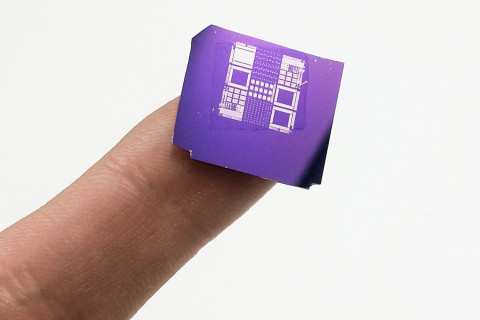Research into graphene, a one atom thick layer of graphite, was blooming in 2010, and the discovery of graphene was expected to cause a technological revolution. However, its great breakthrough is still waiting to happen. Meanwhile, research into other 2D materials is taking over.
Senior Researcher Dr Tommi Kaplas still believes in the success of graphene. Kaplas has been involved in graphene research on the Joensuu Campus of UEF for the past ten years.
“Graphene was discovered in 2004. In the same year, research into graphene and other carbon nanomaterials began in Joensuu under the lead of Professor Alexander Obraztsov and Professor Yuri Svirko. Globally, an enormous amount of research was dedicated to graphene synthesis, properties and applications in 2005-2015. Currently, the graphene hype is cooling down, but this does not mean that the properties of graphene would have weakened in any way,” Kaplas says
“Its properties are excellent, but due to a very intense research period, it has become very difficult to find new features or potential applications for graphene. Fundamental research into the material does not bring any novelty into the field anymore. This has made many groups change the direction of their research.”
At the University of Eastern Finland, graphene and carbon nanomaterials are studied in Joensuu and Kuopio. The focus on both campuses is on graphene synthesis. In Joensuu, research focuses on graphene synthesis for optical applications by metallic nanoparticle assisted catalysis. In Kuopio, research is currently focusing on the synthesis of graphene and other carbon nanomaterials s from biomass-based precursors.
“Biomass provides an inexpensive and renewable carbon precursor, which has created great interest globally. Applications relating to energy storage and wastewater filtration in particular have been studied intensively. Furthermore, using graphene in e.g. transparent electrodes has created interest,” Academy Research Fellow Anna Lähde explains.
Synthesis and experimental study of even a single new 2D material is a major breakthrough
Before 2004, it was a common belief that 2D materials couldn’t exist. People believed, and it was even proven theoretically, that 2D materials roll or curl up due to thermodynamic reasons.
“In 2004, all of this changed when Andre Geim and Konstantin Novoselov experimentally verified the existence of two-dimensional graphene. They were later awarded a Nobel Prize in physics, but most importantly, their research opened doors for research into graphene and other 2D materials,” Kaplas says.
A bunch of other 2D materials have appeared alongside graphene, for instance silicene (2D silicon), germanene (2D germanium), tellurene (2D tellurium), molybdenum disulfide (MoS2), molybdenum selenide (MoSe), black phosphorus and hexagonal boronitride.
“After graphene, the existence of many other 2D materials has been confirmed and one may expect that more are yet to come. In theory, there could be even thousands of different materials, but in practice the synthesis and experimental verification of a single new 2D material would be a great breakthrough.”
In 2015, the EU started a billion-euro, ten-year project, the Graphene Flagship, which aims at utilising graphene and similar materials for the benefit of mankind. The project is now approaching half-way and research within the project is slowly moving from laboratories toward industry.
“One aim of the EU’s flagship is to harness graphene for the use of technology. This will require introducing graphene into industry, but it can be a long way before this happens,” assumes Kaplas, whose own interests also follow the general roadmap of the field.
Synthesis of graphene causes a headache
The synthesis of graphene has been one of the most fundamental issues causing a headache. It is possible to grow a one atom thick layer of carbon in the laboratory, but processing it on an industrial scale is another story.
”Introducing one atom thick materials into commercial devices, components or even serial production has been more difficult than predicted,” Kaplas says.
The synthesis of one atom thick materials requires also a lot from the equipment. The quality has to be excellent. Conventionally, graphene has been synthesised by chemical vapour deposition on transient metal foils, like on copper.
“On a copper foil it grows nicely. However, the copper substrate makes graphene worthless for optics and electronics. Therefore, the graphene film has to be transferred from copper onto a silicon or a glass substrate,” Kaplas says.
“The transfer of an atomically thin film causes some issues since it requires experience and time. For an experienced researcher, the transfer process may take two or three days, and success is not always guaranteed. From an industrial point of view, this is not very appealing and therefore my study focuses on techniques to synthetize graphene directly on silicon or glass substrates by using different nanocatalysts.”
“Currently the main applications for our materials are found in optics and photonics. For these purposes, graphene that is deposited directly on silicon or glass works perfectly,” Kaplas says.
Tailoring brings out the versatility of 2D materials
Two-dimensional materials have enormous potential in electronics and optics applications. Electrons in those materials can move even with1/300 times light speed. Such high-speed electrons could multiply speeds of computers and communication. However, from point of view of optoelectronics, graphene can be overshadowed by other 2D materials.
Professor Yuri Svirko from the Department of Physics and Mathematics works on the optical and microwave properties of these materials. His recently approved EU consortium is dedicated to studying graphene and other 2D materials in field of optics and photonics.
“I am afraid graphene is not the best material for optics. Other 2D materials have properties that make them more convenient and interesting for applications in optics and photonics,” Svirko says.
“Graphene is lighter than conventional materials and this will make it an appealing material for instance for space application, where every gram counts. However, at the moment we cannot say how reliable those graphene-based detectors and transistors are and for example how space radiation affects them. These are indeed important questions, which will be addressed in our EU-funded project.”
“In addition to ultra-high-speed electrons, two-dimensional materials have some other opto-electronic peculiarities in comparison to corresponding bulk materials. And since these materials are only one atom thick, many of these properties are sensitive to external influences. The properties can be tailored by combining different 2D materials. For instance, one can create a pile of one, two, three or more materials, where every single material is only one atom layer thick,” Kaplas explains.
As an example, an electron mobility of a graphene film on glass can be increased by placing graphene in between two hexagonal boron nitride films. In such a case, the electron mobility can be even 10-20 times higher in comparison to that if graphene would be directly on a glass substrate.
”In some sense the structure of a 2D material pile can be compared to a hamburger. The ‘taste’ (in this case the optical and electronic properties) of the pile is different depending on the materials in the pile. Moreover, the properties of an individual 2D material inside a pile can be controlled by applying an external or internal electric field to the pile. It sounds incredible but is possible,” he says.
“However, things take their time. For instance, the principle of a transistor was invented in the early 20th century. However, it took more than a decade before the first, fist-size transistor was fabricated.”
“Today, a century after the principle of a transistor had been proposed, smart phones and computers may have even billions of transistors. Graphene was found about a decade ago and graphene-based devices are still built in laboratories. However it may be possible that in the beginning of the twenty first century graphene and other 2D materials will be everywhere. Time will tell.”
Dr Kaplas is currently conducting research into terahertz and semiconductor optics in Vilnius, FTMC Institute, Department of Optoelectronics, in Professor Irmantas Kasalynas’ KOTERA-PLAZA project. https://www.ftmc.lt/en/
***
Further reading
Professor Yuri Svirko's research group currently participates in two Marie Curie RISE projects:
- Collective excitation in advanced nanostructures (CoExAn), 2014-2019
- Dirac semimetals based terahertz components (DiSetCom), 2019-2022
Dr Polina Kuzhir, Belarus State University, recently received an H2020 Marie Curie International Fellowship for working in the TURANDOT projekt, 2019-2021
An International Workshop on Nanocarbon Photonics and Optoelectronics is organised at the University of Eastern Finland every second year: www.npo.fi
In the photo: A graphene based THz-sensor prototype.
In the photo: Tommi Kaplas believes that graphene will make a breakthrough on an industrial scale in the near future. Its properties are excellent and suitable e.g. for terahertz (THz) optics.


